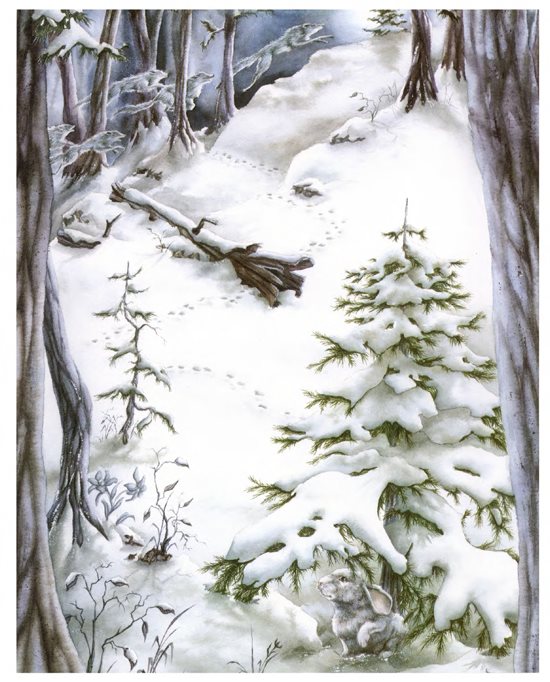
Why
Christmas Trees
Aren't Perfect
RICHARD H. SCHNEIDER
ILLUSTRATED BY
ELIZABETH J. MILES
Abingdon Press
Nashville
Why Christmas Trees Aren't Perfect
Text copyright 1987 by Guideposts Associates, Inc., Carmel, New York 10512.
Adapted from a story by the same name in The Guideposts Family Christmas Book: The Gifts of Christmas, copyright 1981 by Guideposts Associates, Inc.
Art copyright 1988 by Elizabeth Miles
All Rights Reserved
Tins book is printed on acid-free paper.
Book designJ. S.Laughbaum
Library of Congress Cataloging-in-Publication Data
SCHNEIDER, DICK, 1922
Why Christmas trees aren't perfect / Dick Schneider, p. cm.
Summary: Even though its kind sacrifices for the animals of the forest have marred the perfection of its shape, Small Pine is selected to be the Christmas tree in the Queen's castle, demonstrating that living for the sake of others makes us most beautiful in the eyes of God.
ISBN13: 978-0-687-45363-4 (alk. paper)
[1. TreesFiction. 2. Christmas treesFiction. 3. KindnessFiction. 4. Christian lifeFiction.] I. Title.
PZ7.S3624Wh 1987 [Fic]dc19 87-20571
Printed in China
07 08 09 10 11 12 13 14 1520 19
B ut long, long ago all evergreen trees were perfect. Each one took special pride in branches that sloped smoothly down from pointed top to evenly shaped skirt.
This was especially true in a small kingdom far beyond the Carpathian Mountains in Europe. Here the evergreen trees were the most beautiful of all. For here the sun shone just right, not too hot, not too dim. Here the rain fell just enough to keep the ground moist and soft so no tree went thirsty. And here the snow fell gently day after day to keep every branch fresh and green.
E ach year as Christmas approached, the Queen's woodsmen would search the royal evergreen forest for the most perfect, most beautiful tree. The one fortunate enough to be chosen would be cut on the first Saturday of Advent. It would then be carefully carried to the castle and set up in the center of the great hall. There it reigned in honor for all the Christmas celebrations.
Out in the hushed forest every evergreen hoped for this honor. Each tree tried to grow its branches and needles to perfection. All of them strained to have the best form and appearance.
O ne tree, Small Pine, grew near the edge of the forest and promised to be the most beautiful of all. As a seedling it had listened carefully to the older trees who knew what was best for young saplings. And it had tried so very hard to grow just right. As a result, everything about Small Pine, from its deep sea-green color to the curling tip of its evenly spaced branches, was perfect.
It had, in fact, already overheard jealous whispers from the other trees. But it paid them no mind. Small Pine knew that if one did one's very best, what anyone else said didn't matter.
O ne cold night, when a bright full moon glittered on the crusty snow, a little gray rabbit came hopping as fast as he could into the grove of evergreens. The rabbit's furry sides heaved in panic. From beyond the hill came the howling of wild dogs in the thrill of the hunt. The bunny, his eyes wide with fright, frantically searched for cover. But the dark, cold trees lifted their branches artfully from the snow and frowned. They did not like this interruption of their quiet evening when growing was at its best.
Faster and faster the rabbit circled as the excited howling of the dogs sounded louder and louder.
A nd then Small Pine's heart shuddered. When the terrified rabbit ran near, Small Pine dipped its lower branches down, down, down to the snow. And in that instant before the wild dogs broke into the grove, the rabbit slipped under Small Pine's evergreen screen. He huddled safely among the comforting branches while the dogs galloped by and disappeared into the forest.
I n the morning the rabbit went home to his burrow, and Small Pine tried to lift its lower branches back up to their proper height. It strained and struggled, but the branches had been pressed down too long through the night. Oh well, Small Pine thought, nomatter. Perhaps the woodsmen wouldn't notice a few uneven branches near the ground in a tree so beautiful.
S everal days later a terrible blizzard lashed the land. No one remembered ever having so much wind and snow. Villagers slammed their shutters tight while birds and animals huddled in their nests and dens.
A brown mother wren had become lost in the storm. With feathers so wet she could barely fly, she went from one large evergreen to another looking for a shelter. But each tree she approached feared the wren would ruin its perfect shape and clenched its branches tight, like a fist.
Finally, the exhausted wren fluttered toward Small Pine. Once more Small Pine's heart opened and so did its branches. The mother wren nestled on a branch near the top, secure at last. But when the storm ended and the bird had flown away, Small Pine could not move its top branches back into their perfect shape.
In them would be a gap evermore.
D ays passed and winter deepened. The packed snow had frozen so hard that the deer in the forest could not reach the tender ground moss, which they ate to survive. Only the older, stronger deer could dig through the icy snow with their hooves.
One little fawn had wandered away from his mother. Now he was starving. He inched into the pine grove and noticed the soft, tender evergreen tips. He tried to nibble on them, but every tree quickly withdrew its needles so the tiny deer teeth couldn't chew them.
Thin and weak, he staggered against Small Pine. Pity filled the tree's heart and it stretched out its soft needles for the starving fawn to eat. But alas, when the deer was strong enough to scamper away, Small Pine's branches looked very ragged.
S mall Pine wilted in sorrow. It could hear what the larger, still-perfect trees were saying about how bad it looked. A tear of pine gum oozed from the tip of a branch. Small Pine knew it could never hope for the honor of being the Queen's Christmas tree.
Next page




















